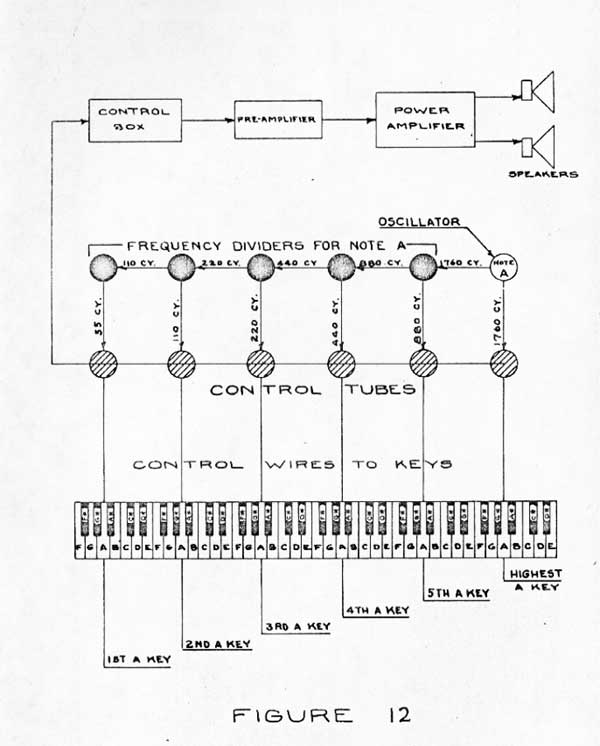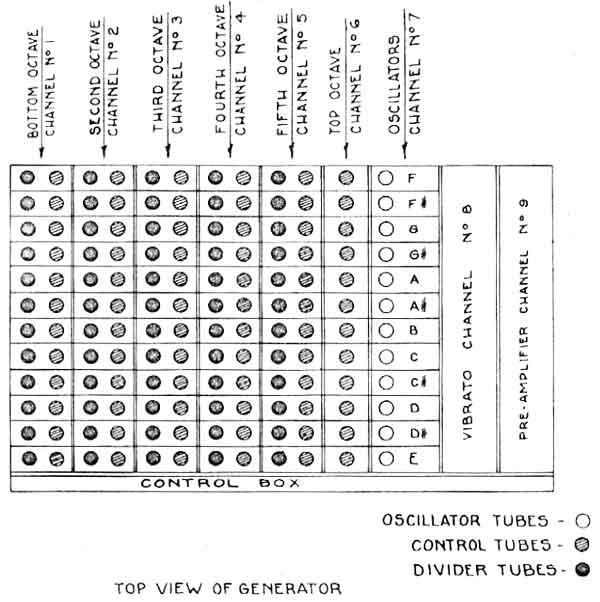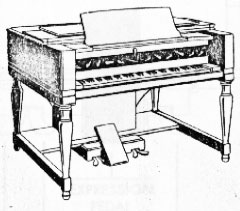|
OPERATION OF THE NOVACHORD
The Novachord is unique among musical instruments in that the player may control the "attack", or growth and decay characteristics, of the tones produced in addition to having available a wide range of effective tone qualities.
The control panel immediately above the keyboard contains the various controls affecting the tones of the instrument. Below the keyboard are the sustaining pedals and the expression pedal.
The left half and right half of the control panel is below.


STARTING THE NOVACHORD
A single switch at the right end of the control panel turns the instrument on and illuminates a small pilot light. Allow about thirty seconds after turning on for the vacuum tubes to warm up. Then lift and release the lever marked "Starter". The Novachord is now ready to play.
TONE CONTROLS
The first six controls at the left side of the control panel are the tone controls. "Deep Tone" is a low pass fitter which emphaslses the lower frequencies; "First Resonator", "Second Resonator" and ''Third Resonator" are tuned circuits which emphasize particular ranges of frequency; "Brilliant Tone" is a high pass filter which emphasizes the higher frequencies; and "Full Tone" passes all frequencies equally.
The tone controls are connected in the output circuit of the tone generator and act on all notes of the instrument. Each has three loudness positions in addition to "Off" . When all slx are "off" no sound may be produced by the instrument.
BALANCER
The Balancer, located in the center of the control panel, slightly reduces the volume of the lower half of the keyboard by shunting fixed resistors across the output circuits. In position 3 (strong bass) it is open and has no effect.
BRIGHT-MELLOW CONTROL
This control, located above the Balancer, affects the entire keyboard except the lower 18 notes. In the mellow position it closes switches which reduce the harmonic content of the tone by introducing condensers into the control tube circuits.
ATTACK CONTROL
The tone of the Novachord may be made percussive, with a sharp attack after whlch the tone gradually dies away, or the tone may be made to have a perceptible period of growth after which it is sustained as long as a key is depressed. These effects are governed by the attack control which is located at the right of the balancer. The attack control has seven positions ranging from "Fast" to "Slow" and operates a multi-contact switch which varies the operating voltage applied to the key circults.
COMBINATION CONTROL
The combination control is a mechanical device which simultaneously moves all controls necessary to obtain two contrasting types of tone most generally used. It has two positions, "Percussion" and
"Singing". When the other controis are operated, the combination control in most cases returns to a neutral position half way between its operating positions.
VOLUME CONTROL
This control is supplementary to the expression pedal and serves to limit the maximum volume of the instrument yet preserves the full range of the expression pedal. It has four positions, position 4 being the loudest.
VIBRATO CONTROLS
The vibrato controls introduce a periodic variation in frequency or pitch of all notes. This effect is produced by six vibrating reeds within the instrument. "Normal Vibrato" and "Small Vibrato" controls each introduce a certain amount of this effect. "Normal Vibrato" produces a greater variation than "Small Vibrato", and both may be used together to increase the effect.
VIBRATO STARTER
This device is used to start the motion of the vibrato reeds each time the Novachord is turned on. The reeds will often start themselves, but for reliable operation they must be started manually, after which they are kept in motion by electrical means as long as the instrument is turned on. A gentle lift and release of the lever is sufficient to start the reeds. l
EXPRESSION PEDAL
The expression pedal of the Novachord is similar to the "swell" pedal of an organ and is used to regulate the volume of the instrument. It operates a variable condenser connected in the pre-amplifier circuit.
SUSTAINING PEDALS
The sustaining pedals, located on either side of the expression pedal, are similar in affect to the "damper" pedals on a piano. They cause the tones of the Novachord to sustain after the playing keys are released by removing cut-off blas from the control tubes. The bass sustaining pedal, located at the left, affects only the lower 36 notes of the keyboard, while the other two operate over the entire keyboard. The pedals affecting the entire keyboard are duplicates in order to allow the player the option of using either foot for operation.
SCHEME OF OPERATION
The tones of the Novachord originate in vacumn tube oscillator and divider circuits. The figure below illustrates the operation of the osclllator and dividers for the six "A" notes of the instrument.

There is a similar oscillator and five dividers for each of the other notes of the musical scale. As there are twelve notes in the musical scale, there are tweive oscillators and sixty dividers in the Novachord, or one tone-producing tube for each of the seventy-two playing keys. The twelve oscillators operate at the frequencies of the highest octave of the instrument (F to E inclusive).
Each frequency divider is a non-linear amplifier operating in such a manner that its output signal has half the frequency of its input signal, and therefore the musical interval between two consecutive dividers is one octave. Referring to Figure 12, it may be seen how the dividers are cascaded and thereby supply the different octaves of the note "A".
Associated with each oscillator (6C8-G) and with each divider (6W7-G) is a control tube (6W7-G) which acts as a valve operated by a playing key. There is one control tube for each of the seventy-two playing keys. Signals from the oscillators and dividers are allowed to pass through the control tubes when a playing key is depressed, after which they are modified as to quality in the control box and pass on to the amplification system, which drives two twelve-inch dynamic speakers.
The positions of the 144 vacuum tubes making up the oscillators and frequency dividers is shown below. In addition, there are two tubes (6J7s) in the pre-amplifier and seven in the power amplifier (using four 2A3s in a parallel/push-pull circuit.) The power supply uses ten tubes. The total number of vacuum tubes is 163.

|




